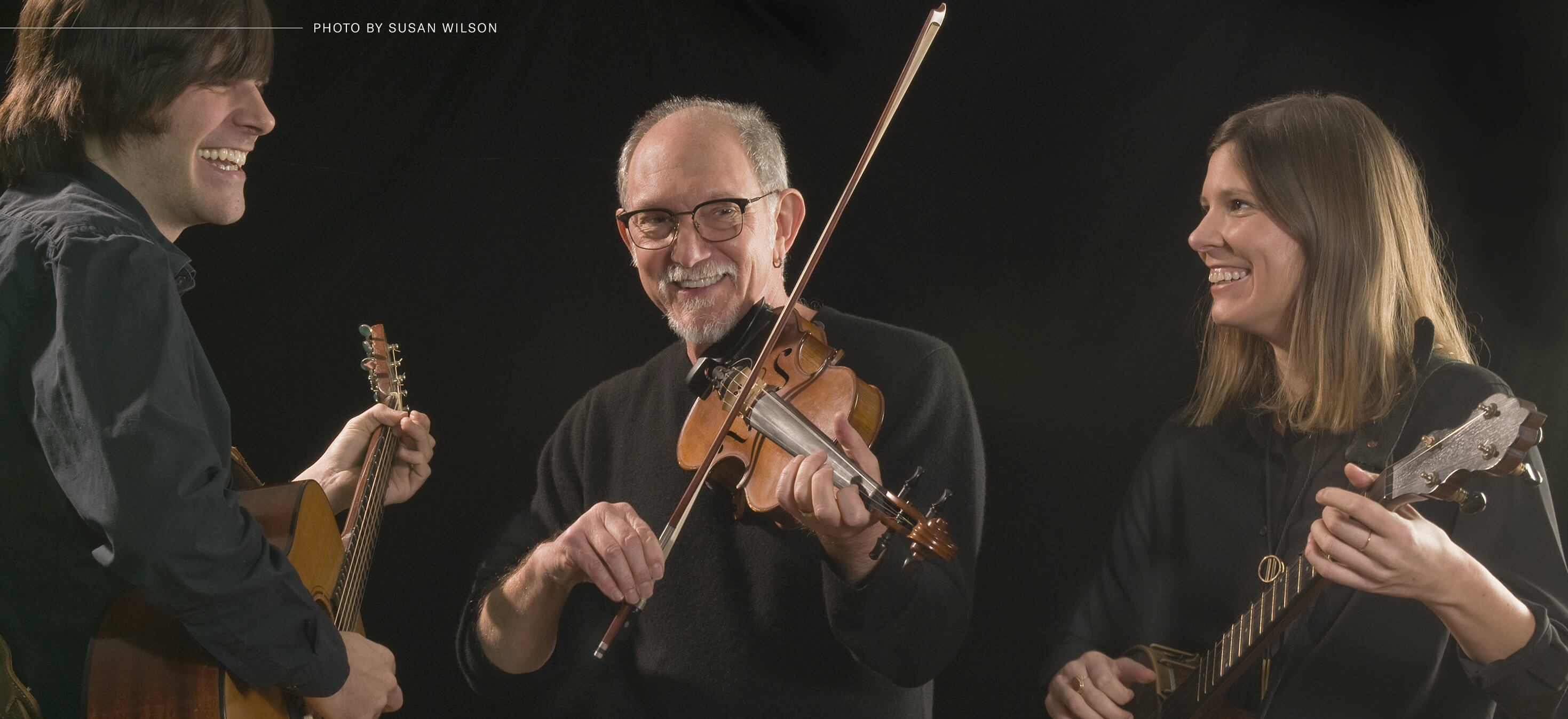ABOUT Bruce Molsky
He's a self-described "street kid" from the Bronx who bailed on college and big city life for a cold-water cabin in Virginia in the 1970s. His mission? To soak up the passion for authentic Appalachian mountain music at the feet of its legendary pioneers, the old masters now long gone.
Today, Bruce Molsky is one of the most revered "multi-hyphenated career" ambassadors for America's old-time mountain music. For decades, he's been a globetrotting performer and educator, a recording artist with an expansive discography including seven solo albums, well over a dozen collaborations and two Grammy-nominations. He's also the classic "musician's musician" – who has received high praise from diverse fans and collaborators like Linda Ronstadt, Mark Knopfler, Celtic giants Donal Lunny and Andy Irvine, jazzer Bill Frisell and dobro master Jerry Douglas, a true country gentleman by way of the Big Apple aptly dubbed "the Rembrandt of Appalachian fiddlers" by virtuoso violinist and sometimes bandmate Darol Anger.
Molsky digs deep to transport audiences to another time and place, with his authentic feel for and the unearthing of almost-forgotten rarities from the Southern Appalachian songbook. His foils are not only his well-regarded fiddle work, but banjo, guitar and his distinctly resonant vocals. From tiny folk taverns in the British Isles, to huge festival stages, to his teaching at the renowned Berklee College of Music where Bruce is the Visiting Scholar in the American Roots Music Program, Molsky seduces audiences with a combination of rhythmic and melodic virtuosity and relaxed conversational wit – a uniquely humanistic, down-home approach that could make Carnegie Hall feel like a front porch or parlor jam session.
The ever-busy Molsky continues to pioneer new ground on several fronts. Molsky's Mountain Drifters' second recording, Closing The Gap, was released earlier this year (2019) and continues to receive rave reviews for its imagination, technical virtuosity and forward-thinking approach to bringing old-time mountain music into present times. Banjo virtuoso and band member Allison de Groot of "The Goodbye Girls" and "Oh My Darling" met Molsky at one of his workshops at Berklee, where his interest was piqued when "she played Lester Young solos on claw hammer banjo." The band's third member, guitarist Stash Wyslouch, is one of bluegrass music's true genre benders, a high-energy performer who cut his teeth in punk and metal bands before immersing himself in roots music with "The Deadly Gentlemen."
Bruce's recent "Can't Stay Here This a-Way" is a unique CD/DVD collection recorded in Los Angeles for David Bragger's Tiki Parlour series. Not a recording session in the traditional sense, Bruce just showed up, sat on a couch while the camera rolled – capturing all the spontaneity as he casually reeled off traditional favorites and some new offerings. He continues to reach out to different cultures with "Rauland Rambles" from Molsky and his Finnish and Norwegian collaborators, Arto Järvelä and Anon Egeland. Mozaik, Bruce's long-time collaboration with Irish music greats Andy Irvine and Dònal Lunny, will be releasing a new recording later in 2019.
In addition to his many live performances as a solo and with Molsky's Mountain Drifters, Bruce tours with Shetland fiddle master Aly Bain and Swedish folk icon Ale Möller. Finding common musical and personal ground with musicians of other cultures is a vital part of what motivates Bruce's music, for the unique music that results, and also for what it allows him to bring back to his own old-time musical voice. Bruce's ongoing collaboration with the great banjoist Tony Trischka will result in a duet recording in the near future as well.
So how does a street kid from the Bronx with plans for a career in architecture and a passion for Jimi Hendrix become a pre-eminent performer and preservationist for a homespun musical idiom forged a world away?
"I grew up in the Bronx in the 1960s, and was glued to AM pop radio," says Molsky. "I started playing guitar when I was ten, when Dr. Billy Taylor and his Jazzmobile program visited my school. I already loved the Beatles, Motown, and Bob Dylan, but Dr. Taylor did something to me that day, he made ME want to play. And that was the day I went home and asked my mom for guitar lessons. And like a lot of kids at that time, I tried to be Jimi Hendrix and played in a string of pretty awful rock bands. But I also became very serious about finger style guitar, and that has stayed with me all along."
"Traditional music came into my life when I was 12, when my sister bought me the first Doc Watson LP and I was blown away by 'Black Mountain Rag,'" continues Molsky. "I came up at the tail end of the folk revival in New York, catching concerts by people like Bill Monroe, Ralph Stanley and Curly Ray Cline as they came through for the Newport Folk Fests. I picked up the fiddle at 17, six months after I had started playing banjo."
Through his teenage years, Molsky honed his skills at nurturing folk gatherings in New York and the Northeast, including the annual Fiddlers' Convention at South Street Seaport. Hoping to please his engineer father, Molsky began studying architect and engineering at Cornell. A blow to these designs was the folk scene at and around Cornell, which only served to deepen his interest in, and ultimate pilgrimage to, the roots of early rural music.
"I left Cornell after two years and decided to follow the music," adds Molsky. "I eventually moved to Virginia and got a job working in a carpet mill. But my main focus was weekly road trips to the mountains of Virginia and West Virginia, to learn from old masters like Tommy Jarrell."
"As a teenager I loved the idea of living in the country, the notion of a simpler life, the romance that's what the music represented to me and had a lot to do with my moving south," continues Molsky. "There are many regional styles of fiddling, but what I like is where the melodies are rhythm based, where the rhythm of bow is totally locked in with the melody," he continues. "It's a style that goes all the way from Virginia down to North Carolina, Georgia and Alabama."
After his style-forging Southern pilgrimage, Molsky performed regularly in the U.S., but didn't make the total chord-cut with 9-to-5 life until his 40th birthday.
"I had a good career as a mechanical engineer, playing music in the off-hours – playing festivals and giving fiddle and banjo workshops," adds Molsky. "But when my father passed, I decided to see if I could make a go of it as a full-time musician. The plan was to take a year off and see how it went; that was in 1997. I never went back!"
Molsky's recording career has been plentiful with nearly two dozen releases available via Rounder and Compass Records and his own Tree Frog Music. His discography includes seven solo albums, from his debut of fiddlers' classics, "Warring Cats," to his most recent, "If It Ain't Here When I Get Back," an "aural autobiography" paying tribute to the musicians who have shaped his musical life and his travels from Appalachia to Australia. There's also the Grammy-nominated "Fiddlers 4," with Darol Anger, Michael Doucet and cellist Rushad Eggleston, Mozaik with Andy Irvine, and contributions to legendary guitarist Mark Knopfler's "Tracker" and the Billboard chart-topping Anonymous 4 release, "1865 – Songs of Hope and Home from the American Civil War."
Bruce's live and recorded work has not only drawn raves from his fellow musicians but the media. No Depression calls Molsky "an absolute master," and featured him in an interview earlier this year, while Mother Jones calls him "easily one of the nation's most talented fiddlers... he transports you, geographically, historically and most of all emotionally. NPR says "his playing is mesmerizing, transporting and best experienced live."
The life of a full-time musician and educator at Berklee and music camps far and wide keeps Bruce away from his Beacon home for half the year. Much of Bruce's recent sojourning has been overseas, to the British Isles, Italy, Scandinavia and a far afield as Australia.
"Performing and teaching traditional music is the biggest thing in my world," concludes Molsky. "For me, being a musician isn't a standalone thing; it informs everything I do in my life. It's always been about being creative and being a part of something much bigger than myself, a link in the musical chain and part of the community of people who play it and love it."
brucemolsky.com






